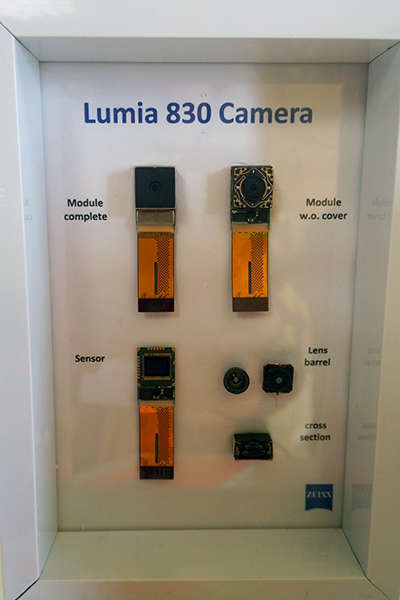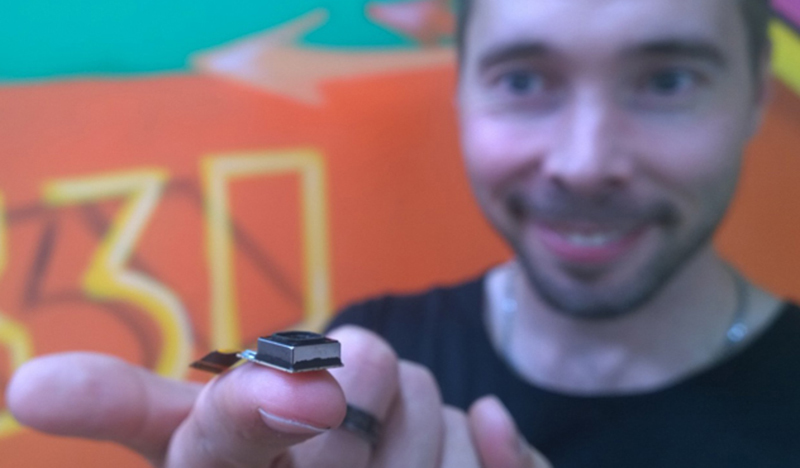Creating PureView: How Zeiss Helps Us Make Cameras
In early October, Microsoft announced the start of sales in Russia of new smartphones Lumia 830 and Lumia 730/735 . The devices will be offered at recommended prices - 19,990 and 12,990 rubles, respectively.

Introducing these models a month ago in Berlin, we made a special emphasis on the photo capabilities of these smartphones. So, for example, Lumia 830 with a body thickness of only 8.5 has a 10 megapixel camera module with a six-lens optical system. Of course, the development of such complex optics would not have been possible without our long-standing partners, Zeiss. At the largest international conference in the Photokina photo industry, our foreign colleagues were able to speak with Oliver Schindelbeck, Product Research and Development Manager at Zeiss, and Sandra Gold, Product Marketing Manager at this German company. And today we want to share this interview with you.

Many models in our portfolio, ranging from the Lumia 720 to the 41 megapixel Lumia 1020 photo flag or our new Lumia 830, carry the Zeiss logo. And this means only one thing - the photo module uses Zeiss Tessar lenses, whose history goes back to 1902.
Collaboration with Zeiss, the world leader in optics and optoelectronics, began in 2005 with the Nokia N90on which a 2-megapixel camera was installed and which had a unique design with a rotary mechanism. Further, our cooperation only grew and grew stronger. Among the highlights: the appearance of optical image stabilization in the Lumia 920, the world's first 41-megapixel PureView 808 and Lumia 1020 smartphones, the flagship Lumia 930 with a 20 MP camera ... We will definitely return to the topic of cooperation with Zeiss in our next posts, but for now we pass the floor to our colleagues.

Nokia N90
How did the collaboration between ZEISS and Nokia begin?
In the early 2000s, we watched for a long time how the technology of shooting on mobile phones evolved, becoming better and better. However, on the other hand, we understood that until compact sensors with a resolution of at least 2 megapixels appeared, optical systems would not matter much.
The thing is that starting from 2 megapixels, users could evaluate with a naked eye whether a good optical system is installed in their device or not. In the opposite case, the quality of the images was still extremely low. In 2004, we had a hunch that the camera phone industry was about to achieve this goal.
We conducted some research and found that many mobile phone manufacturers are ready to begin cooperation with our company. Without a doubt, Nokia was the best of all at that time.
At the end of 2004, our management contacted the Nokia leadership, and we quickly found that we had the same understanding that the ability to take photos was becoming a very important function in mobile devices, and the cooperation of our companies would become the best “case” in the mobile and photo industries at the same time. As a result, less than three months have passed since our first contact with Nokia until the signing of the agreement.
How is the collaboration between Zeiss and Nokia engineers in terms of material and technical base?
We had an almost weekly team building event when we just started working together. Since then, we have had regular meetings at least twice a year. And when working on current projects, we meet in person, conduct daily newsgroups and send heaps of emails to each other.
Have you encountered any difficulties while developing camera modules for Lumia?
A common and always existing difficulty is the size of the camera module and its height. This is one of the most critical things because it affects the thickness of a mobile phone.
On Lumia devices, such as the 41-megapixel Lumia 1020, the camera module must be thicker to accommodate a large sensor, an optical system, and a stabilization system. Could thinner devices be equipped with similar cameras? Developed in conjunction with Microsoft (and Nokia previously) 20 megapixel camera modules for thinner Lumia 1520 and Lumia 930, although they hint that a compromise is inevitable, but still impress with their characteristics.

The thinnest of the Lumia 830 series is equipped with 10 megapixels and optical image stabilization. Due to the less powerful Lumia 830 photomatrix, we needed a smaller lens diameter. Thus, we created a completely different optical device to make the lens thinner, and thanks to this we also reduced the thickness of the module.
Can you tell us more about how you test cameras designed for Lumia smartphones?
When we have the first prototypes of lenses, modules and ready-made devices, we immediately proceed to laboratory and experimental testing. We can simulate almost any weather conditions on the planet: for example, extreme temperatures.

Quality is measured differently. Image resolution is easy to determine, but this is just one part of the evaluation parameter. The overall quality of the images obtained cannot be measured and evaluated only by equipment. This requires the human eye. Fortunately, we have many specialists in the field of photography.
Last question. What's next? How will camera phones look and work in the future?
We would like to see camera modules that are even thinner. Within the framework of the existing technology, we are getting closer and closer to acceptable boundaries. If you want to have decent image quality when using current technologies, then, I would say, 5-6 mm is probably the limit. However, on the approaches there are other technologies that promise us that in the foreseeable future we can produce significantly thinner modules.

Introducing these models a month ago in Berlin, we made a special emphasis on the photo capabilities of these smartphones. So, for example, Lumia 830 with a body thickness of only 8.5 has a 10 megapixel camera module with a six-lens optical system. Of course, the development of such complex optics would not have been possible without our long-standing partners, Zeiss. At the largest international conference in the Photokina photo industry, our foreign colleagues were able to speak with Oliver Schindelbeck, Product Research and Development Manager at Zeiss, and Sandra Gold, Product Marketing Manager at this German company. And today we want to share this interview with you.

Many models in our portfolio, ranging from the Lumia 720 to the 41 megapixel Lumia 1020 photo flag or our new Lumia 830, carry the Zeiss logo. And this means only one thing - the photo module uses Zeiss Tessar lenses, whose history goes back to 1902.
Collaboration with Zeiss, the world leader in optics and optoelectronics, began in 2005 with the Nokia N90on which a 2-megapixel camera was installed and which had a unique design with a rotary mechanism. Further, our cooperation only grew and grew stronger. Among the highlights: the appearance of optical image stabilization in the Lumia 920, the world's first 41-megapixel PureView 808 and Lumia 1020 smartphones, the flagship Lumia 930 with a 20 MP camera ... We will definitely return to the topic of cooperation with Zeiss in our next posts, but for now we pass the floor to our colleagues.

Nokia N90
How did the collaboration between ZEISS and Nokia begin?
In the early 2000s, we watched for a long time how the technology of shooting on mobile phones evolved, becoming better and better. However, on the other hand, we understood that until compact sensors with a resolution of at least 2 megapixels appeared, optical systems would not matter much.
The thing is that starting from 2 megapixels, users could evaluate with a naked eye whether a good optical system is installed in their device or not. In the opposite case, the quality of the images was still extremely low. In 2004, we had a hunch that the camera phone industry was about to achieve this goal.
We conducted some research and found that many mobile phone manufacturers are ready to begin cooperation with our company. Without a doubt, Nokia was the best of all at that time.
At the end of 2004, our management contacted the Nokia leadership, and we quickly found that we had the same understanding that the ability to take photos was becoming a very important function in mobile devices, and the cooperation of our companies would become the best “case” in the mobile and photo industries at the same time. As a result, less than three months have passed since our first contact with Nokia until the signing of the agreement.
How is the collaboration between Zeiss and Nokia engineers in terms of material and technical base?
We had an almost weekly team building event when we just started working together. Since then, we have had regular meetings at least twice a year. And when working on current projects, we meet in person, conduct daily newsgroups and send heaps of emails to each other.
Have you encountered any difficulties while developing camera modules for Lumia?
A common and always existing difficulty is the size of the camera module and its height. This is one of the most critical things because it affects the thickness of a mobile phone.
On Lumia devices, such as the 41-megapixel Lumia 1020, the camera module must be thicker to accommodate a large sensor, an optical system, and a stabilization system. Could thinner devices be equipped with similar cameras? Developed in conjunction with Microsoft (and Nokia previously) 20 megapixel camera modules for thinner Lumia 1520 and Lumia 930, although they hint that a compromise is inevitable, but still impress with their characteristics.

The thinnest of the Lumia 830 series is equipped with 10 megapixels and optical image stabilization. Due to the less powerful Lumia 830 photomatrix, we needed a smaller lens diameter. Thus, we created a completely different optical device to make the lens thinner, and thanks to this we also reduced the thickness of the module.
Can you tell us more about how you test cameras designed for Lumia smartphones?
When we have the first prototypes of lenses, modules and ready-made devices, we immediately proceed to laboratory and experimental testing. We can simulate almost any weather conditions on the planet: for example, extreme temperatures.

Quality is measured differently. Image resolution is easy to determine, but this is just one part of the evaluation parameter. The overall quality of the images obtained cannot be measured and evaluated only by equipment. This requires the human eye. Fortunately, we have many specialists in the field of photography.
Last question. What's next? How will camera phones look and work in the future?
We would like to see camera modules that are even thinner. Within the framework of the existing technology, we are getting closer and closer to acceptable boundaries. If you want to have decent image quality when using current technologies, then, I would say, 5-6 mm is probably the limit. However, on the approaches there are other technologies that promise us that in the foreseeable future we can produce significantly thinner modules.
